Physical Address
304 North Cardinal St.
Dorchester Center, MA 02124
The gastrointestinal (GI) tract and abdominal wall anomalies are diverse. Although they may occur in isolation, many are associated with syndromic or karyotype abnormalities; thus it is important to search for associated anomalies.
Familiarity with normal development is needed to recognize the varying appearances during gestation of structures such as the abdominal wall with physiologic midgut herniation, the identification of the gallbladder in the latter half of pregnancy, or the appearance of meconium at different stages of gestation.
The prognosis and presentation of a GI tract or abdominal wall anomaly may vary with the stage of gestation.
Anomalies of the GI tract may be diagnosed as part of the evaluation of indirect clues such as polyhydramnios.
Early prenatal diagnosis, in particular of abdominal wall anomalies, may be performed by late first trimester, in conjunction with a nuchal translucency evaluation.
Abnormalities of the GI tract may not be clinically apparent in the newborn; thus prenatal diagnosis facilitates appropriate triage to a center that can provide treatment.
Systematic and thorough evaluation of the fetal gastrointestinal (GI) tract and abdominal wall is critical to ascertain the risk of isolated and multiple fetal abnormalities. Anomalies of the fetal abdomen may be the only sonographic evidence of multisystem organ derangement secondary to conditions such as genetic disorders or fetal infection. Furthermore, detection of fetal intraabdominal masses or abnormalities is important because these conditions may not be detected on the routine newborn examination. In some cases, anomalies of the GI tract may be diagnosed as part of the evaluation of indirect clues such as polyhydramnios.
The GI tract begins to develop in the third and fourth weeks of life. The primitive gut tube is formed by incorporation of the dorsal part of the yolk sac into the embryo following the longitudinal and lateral folding of the embryonic disc. The gut tube is lined by the embryonic endoderm and is closed at its cranial and caudal ends by the oropharyngeal membrane and the cloacal membrane, respectively. Subsequently, the gut tube undergoes regionalization into three portions. The foregut, the most cranial portion, gives rise to the esophagus, stomach, duodenum, liver and bile ducts, and pancreas. The hindgut, the most caudal portion, differentiates into the distal part of the colon (beyond the splenic flexure), which is partially supplied by the inferior mesenteric artery. In between, the midgut gives rise to the largest part of the intestine, which is supplied by the superior mesenteric artery, and includes the second half of the duodenum (distal to the ampulla of Vater), jejunum, ileum, ascending colon, and the proximal two-thirds of the transverse colon. The midgut remains in connection with the yolk sac via the yolk stalk (omphalomesenteric duct or vitelline duct).
The normal fetal esophagus, extending from the pharynx to the stomach, is collapsed and may therefore be difficult to visualize, or it may be demonstrated as two or four echogenic lines representing the esophageal walls.
Developmentally, the trachea and esophagus differentiate inferiorly from the posterior pharynx. Incomplete differentiation of the respiratory and GI tracts can lead to esophageal atresia with or without tracheoesophageal fistulas. The incidence of all types of tracheoesophageal fistulas is 2.8 per 10,000 pregnancies. There are five types of esophageal atresia, with the most common having a fistula to the distal esophagus. Because most types of esophageal atresia (90%) are associated with tracheoesophageal fistulas, in many cases the stomach (although often small) will be visualized on ultrasound, and polyhydramnios may be absent or mild or present only later in gestation ( Table 38.1 ).
| Type | Description | Proportion of Esophageal Atresia (EA) Cases |
|---|---|---|
| A | EA without tracheoesophageal (TE) fistula | 10% |
| B | EA with TE fistula to the proximal esophageal segment | <1% |
| C | EA with TE fistula to the distal esophageal segment | 85% |
| D | EA with TE fistula to both proximal and distal esophageal segments | <1% |
| E | TE fistula without esophageal atresia | 5% |
The main sonographic signs of esophageal atresia include absent or small stomach ( Fig. 38.1 ), polyhydramnios, and the esophageal pouch sign (fluid collection in the blind end of the esophagus) ( Fig. 38.2A ). At times a distended oropharynx will be seen ( Fig. 38.2B , Video 38.1 ). However, the demonstration of esophageal pouch can be difficult because of variation in the location and periodic emptying of the pouch. The antenatal diagnosis of esophageal atresia is challenging, and in many cases the diagnosis is only made during the neonatal period. One study reported the antenatal detection rate of esophageal atresia to be 42%. The combination of inability to see the stomach on ultrasound and the presence of polyhydramnios is more suggestive of esophageal atresia than absent stomach alone, but the positive predictive value of this combination is still relatively modest (56%).
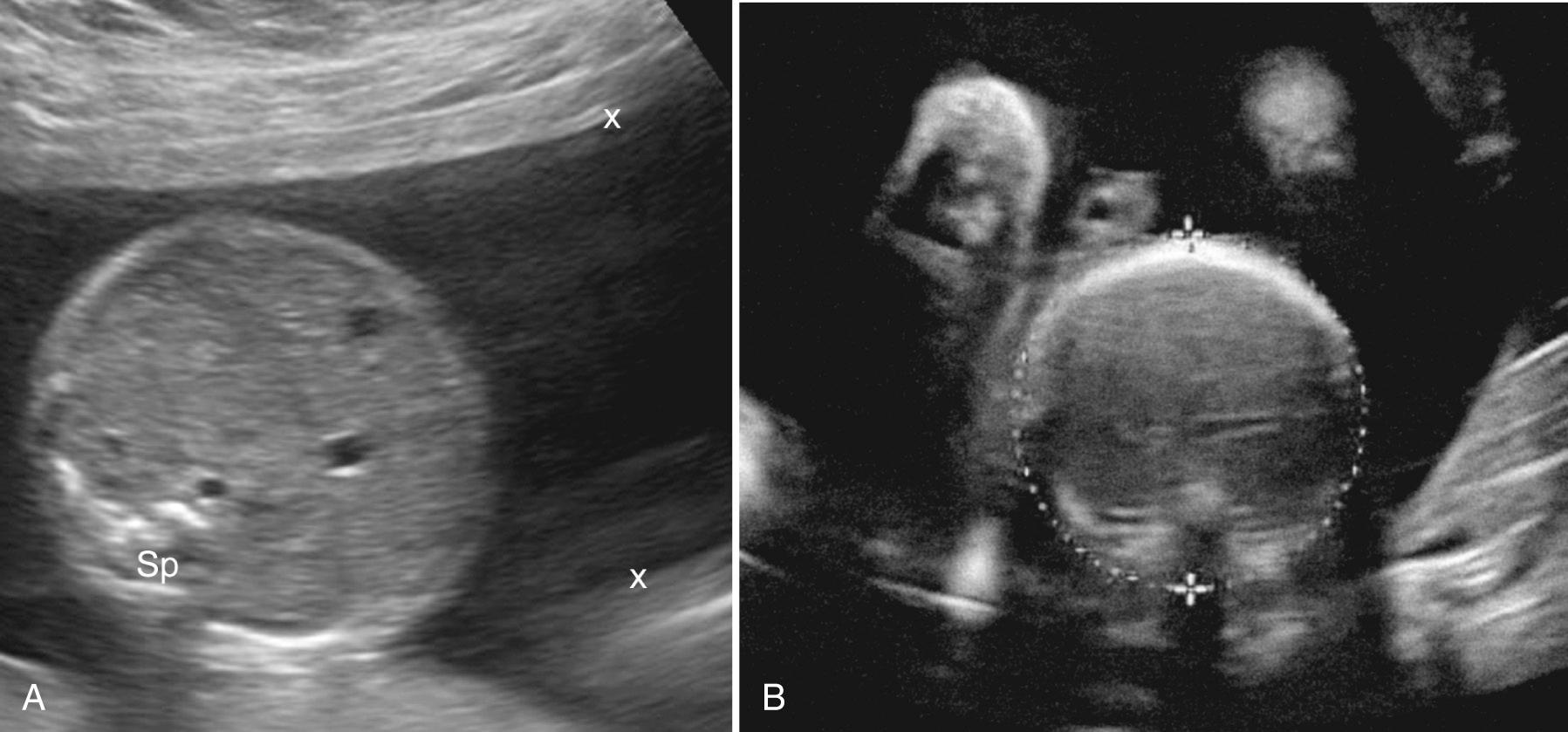
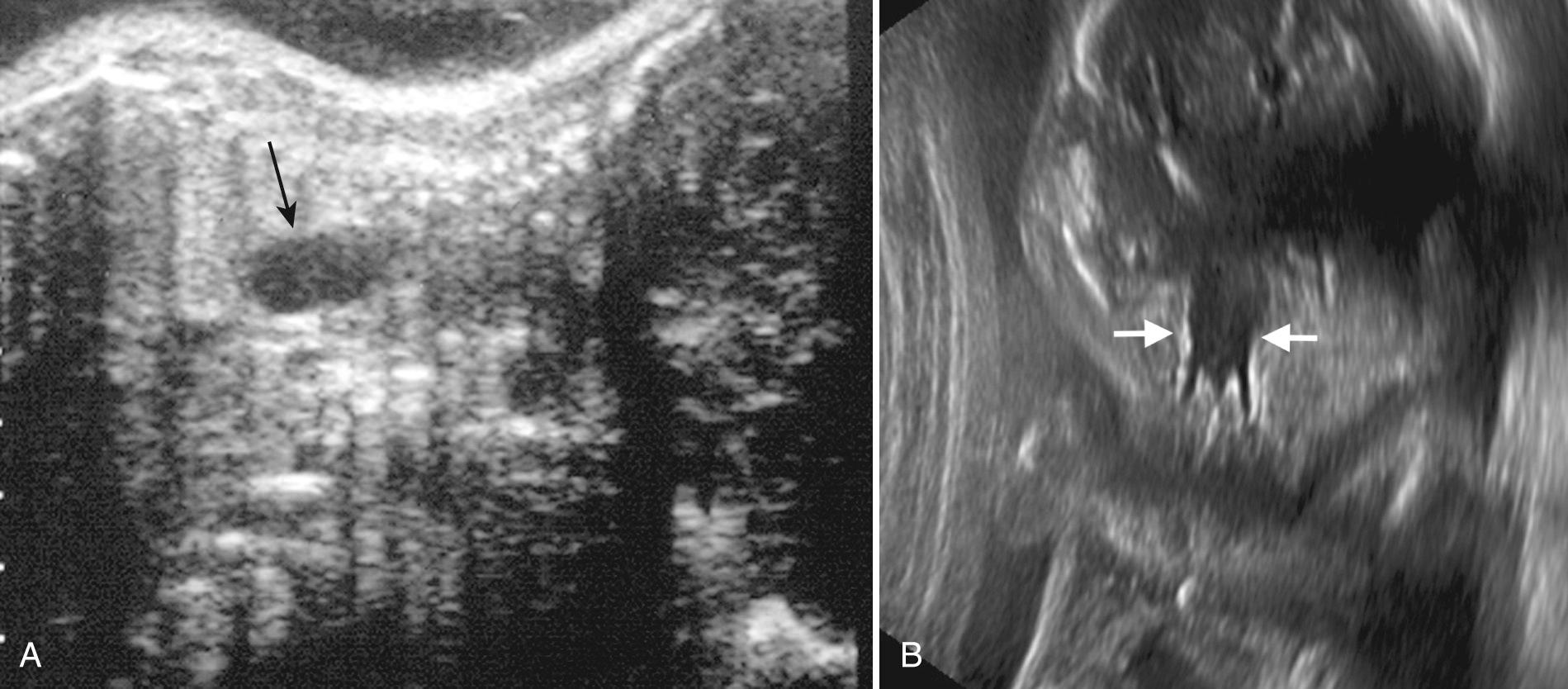
Esophageal atresia is associated with additional anomalies in more than 50% of cases, and a detailed anatomic evaluation, including echocardiography, should be performed in a fetus with this suspected diagnosis. It has been reported that as many as half of tracheoesophageal fistulas are part of the VACTERL sequence, a sporadic nonrandom group of coexisting defects ( v ertebral defects, a nal atresia, c ardiac anomalies, t racheoesophageal fistula with e sophageal atresia, r enal and l imb defects such as radial dysplasia). Amniocentesis should be considered because the risk of aneuploidy ranges from 5% to 10%. Corrective surgery for esophageal atresia has a success rate of 90% and is influenced by the presence of associated anomalies.
The fetal stomach can be seen as early as 7 weeks and should be noted routinely by 13 to 14 weeks' gestation ( Fig. 38.3 ). The stomach should be seen as a cystic structure in the left upper abdomen. It is important to confirm the location of the stomach because a midline or right-sided stomach is associated with heterotaxy syndrome.
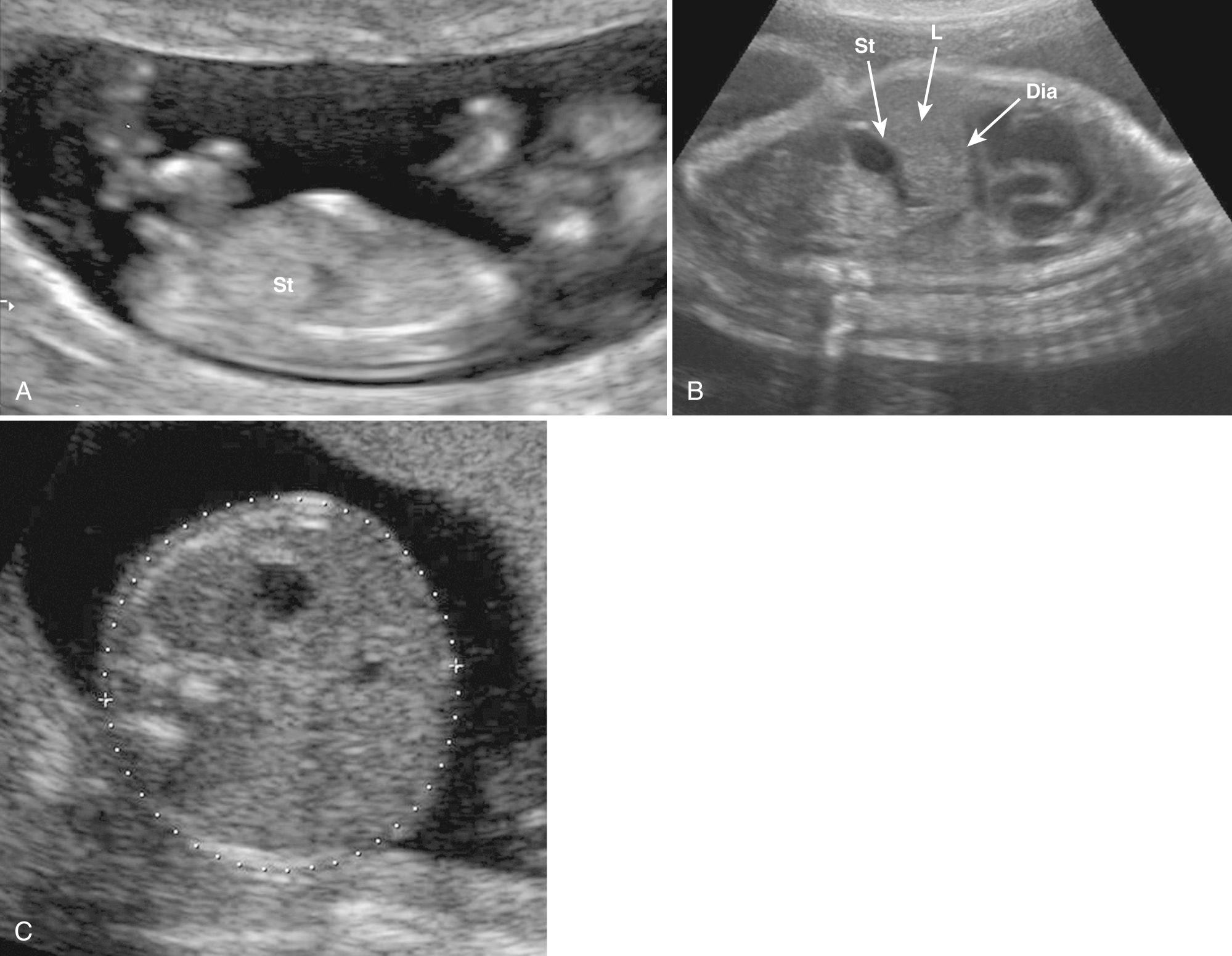
Fluid in the stomach should be reliably visualized on first-trimester screening or fetal anatomic survey and all subsequent fetal evaluations. Nonvisualization of the stomach on an anatomic survey (see Fig. 38.1 ), although potentially a normal finding following recent emptying of the stomach, is associated with an increased risk of fetal abnormalities and may be the result of esophageal obstruction or atresia, disorders affecting the mechanism of swallowing, severe oligohydramnios (which limits the amount of amniotic fluid swallowed by the fetus), or abnormal location of the stomach.
Esophageal atresia
Esophageal compression (e.g., goiter, tumor or masses in the pharynx, lungs, or mediastinum)
Anatomic factors (e.g., cleft palate)
Neurologic disorders
DISPLACEMENT OF THE STOMACH
Congenital diaphragmatic hernia
Abdominal wall defects
Heterotaxy syndromes
When the stomach appears small or absent, it is important to allow sufficient time for it to fill, in case it has recently emptied. Generally, the stomach will fill during a 30-minute examination. Careful attention must be paid to the amniotic fluid volume (oligohydramnios or polyhydramnios), general tone and presence of swallowing movements, the appearance of the thorax and diaphragm (masses, diaphragmatic hernia), and abdominal situs.
In one retrospective study, an abnormal outcome (structural abnormalities, antenatal or postnatal death) occurred in 23 (85%) of 27 fetuses with an absent stomach and 27 (52%) of 52 fetuses with a small stomach (combined, 63%). Karyotype was abnormal in 8 (38%) of 21 fetuses with an absent stomach and 2 (4%) of 46 fetuses with a small stomach. For these reasons, the finding of a persistently absent stomach on serial ultrasound scans should trigger a detailed anatomic assessment, genetic counseling, and consideration of chromosomal testing.
In the second or third trimester a prominent or transiently dilated fetal stomach may be seen on ultrasound. Use of a nomogram can aid in identifying true outliers. However, there is a considerable variation in the normal size of the stomach, and given the asymmetrical shape of the stomach, standardization of the measurement of the stomach dimensions is difficult. In addition, because of the considerable normal fluctuations in stomach size, the diagnosis of a dilated fetal stomach requires that the stomach be persistently dilated throughout a 30-minute assessment as well as on successive examinations. The differential diagnosis of a dilated fetal stomach includes normal variation in stomach size and GI atresia (e.g., duodenal atresia, pyloric atresia ) as well as pyloric stenosis ( Fig. 38.4 ).
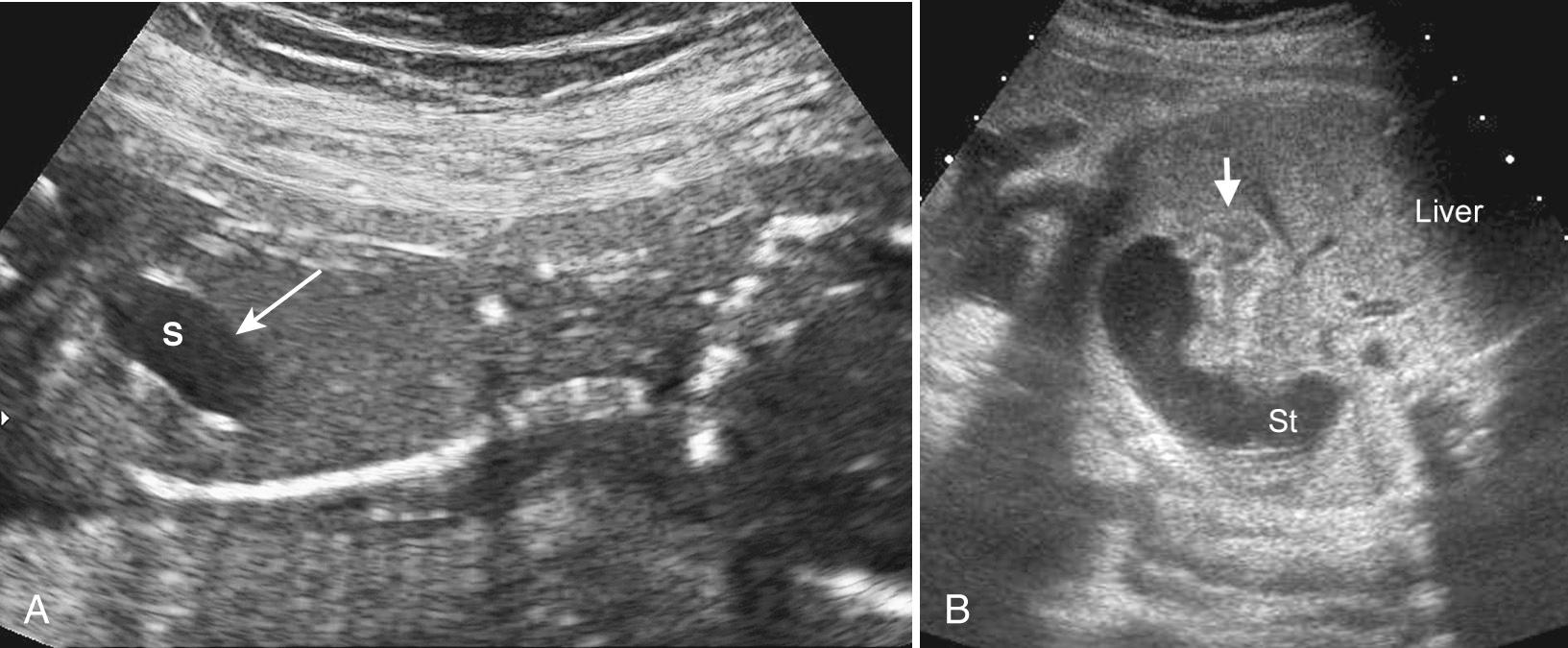
Pyloric atresia is a rare form of intestinal atresia. The underlying cause is thought to be different than that of atresia of other parts of the GI tract, and a familial form with an autosomal recessive transmission is well documented. A unique aspect of pyloric atresia is the association with epidermolysis bullosa, an often fatal skin disorder characterized by blisters in the skin and mucosal membranes which is inherited in an autosomal recessive pattern. The main sonographic findings in cases of pyloric atresia include gastric dilatation (which can be massive), esophageal dilatation caused by gastroesophageal reflux, and severe polyhydramnios. The co-presence of epidermolysis bullosa may be suggested by elevated levels of maternal serum alpha-fetoprotein and snowflake appearance of the amniotic fluid and can be confirmed by molecular analysis of fetal skin biopsy.
An abnormal position of the stomach is an important clue for the presence of a severe abnormality and therefore requires detailed anatomic assessment. A right-sided stomach ( Fig. 38.5B ) should raise the possibility of heterotaxy syndrome, which is characterized by an abnormal symmetry of the viscera and veins and is associated with complex cardiac anomalies, intestinal malrotation, and splenic (asplenia or polysplenia) ( Fig. 38.6 ) and hepatic abnormalities. The incidence of heterotaxy syndrome with asplenia or polysplenia is 0.45 per 10,000 pregnancies. Because of the combined cardiovascular and GI abnormalities, infant mortality is high, with the 1-year mortality rate reaching 32%. A midline stomach can represent i ntestinal malrotation.
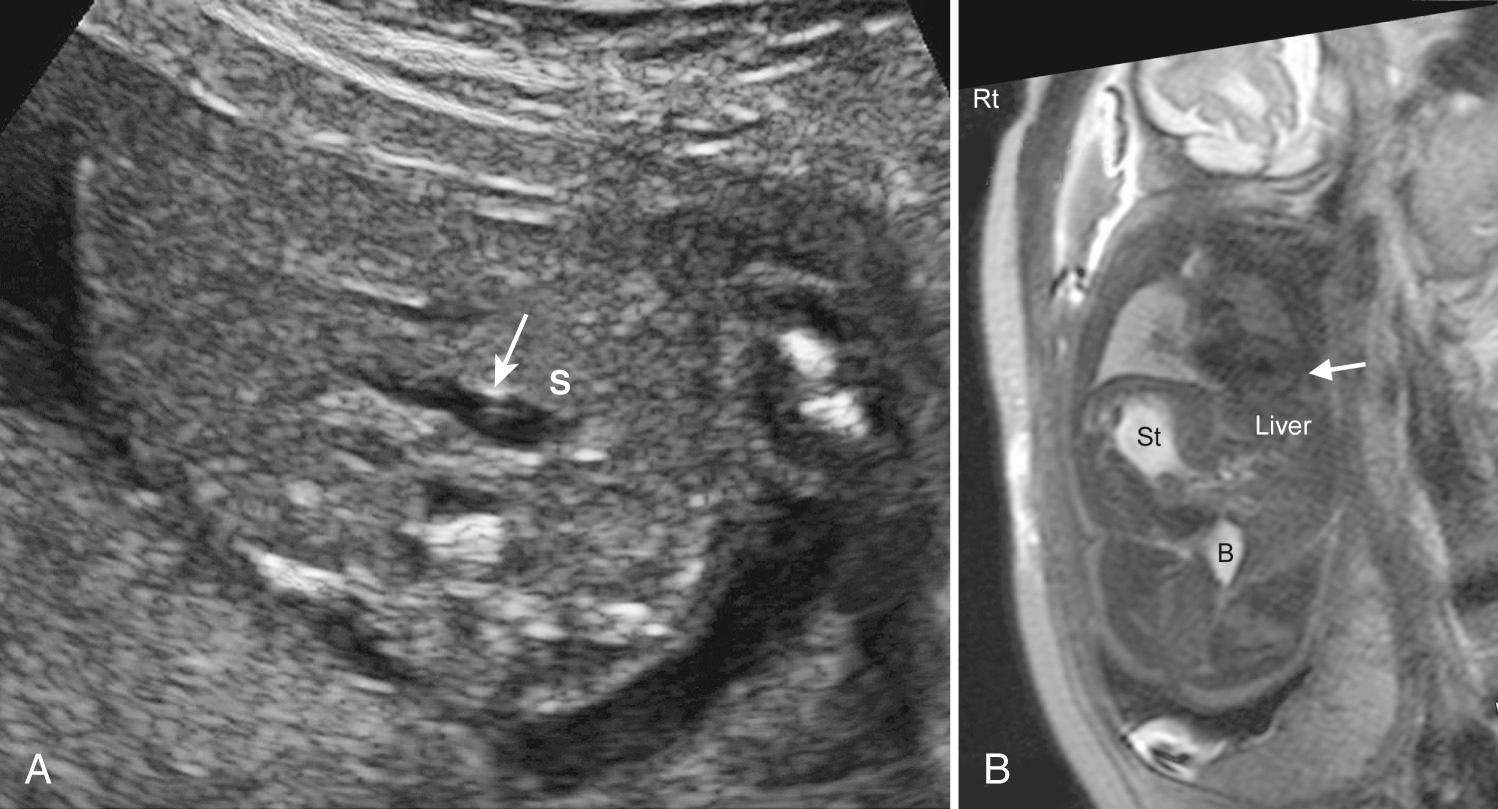
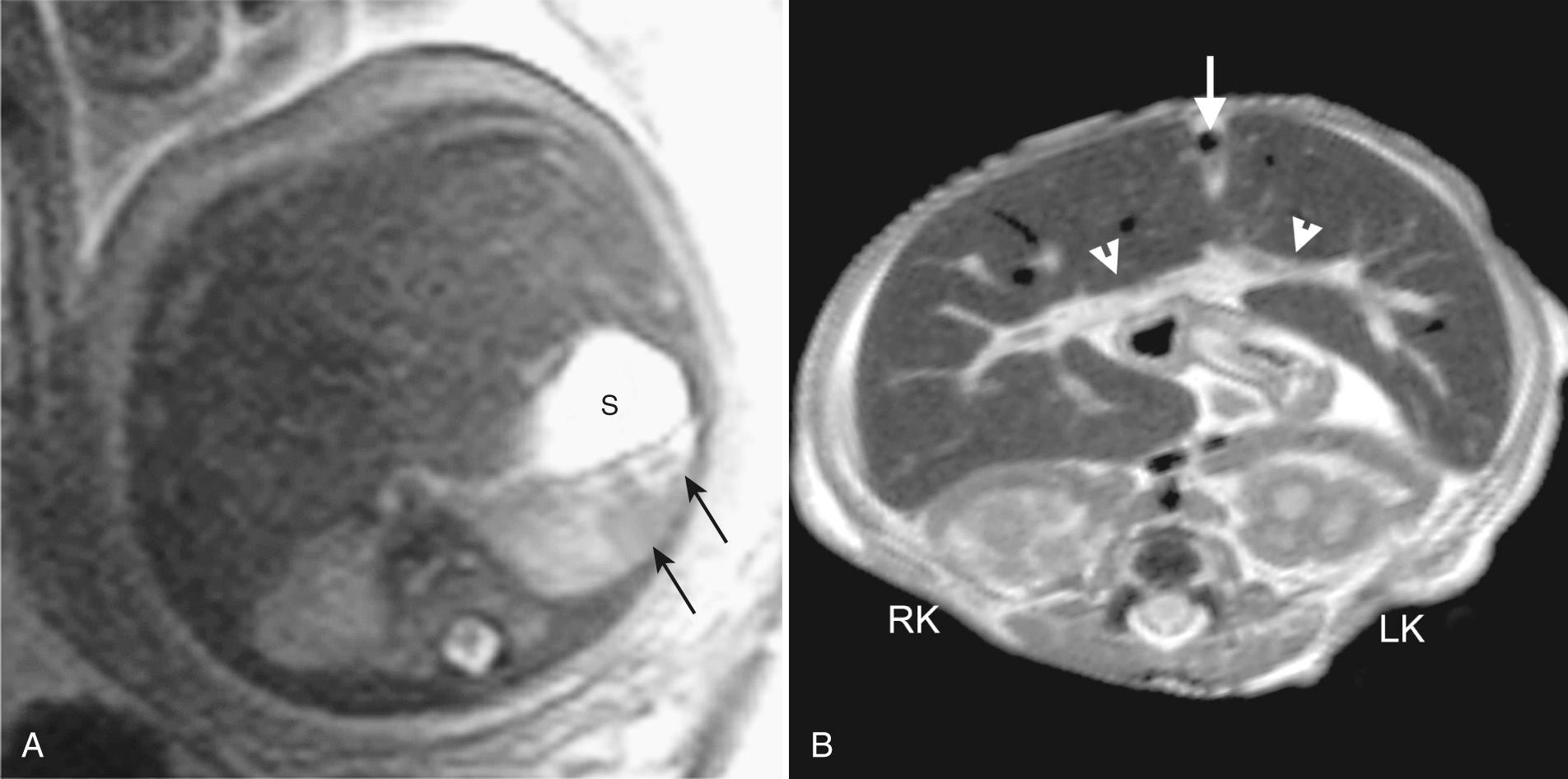
The presence of irregular echogenic content or debris within the fetal stomach can often be seen on routine ultrasound exams ( Fig. 38.7 , Videos 38.2 and 38.3 ). This finding is nonspecific and when found in isolation it is most likely to be a normal finding. Such debris most often represents blood, skin cells, or meconium swallowed by the fetus.
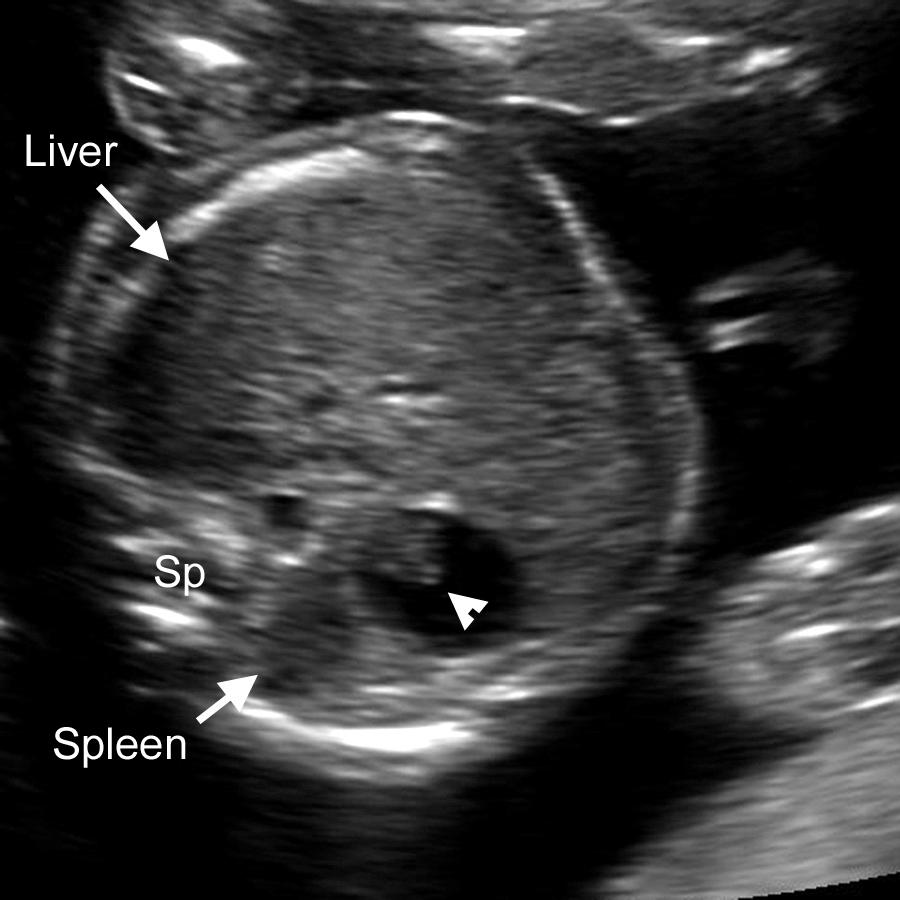
In the first trimester and early in the second trimester, the small and large bowel appear somewhat heterogeneous, with an echogenicity similar to that of the liver. Later in pregnancy, fluid can be seen in the small bowel loops, and meconium can be seen in the colon. Most cases of GI atresia are thought to represent a failure of recanalization of the bowel lumen, which is a solid tube early in fetal life.
Dilatation of the duodenum resulting from duodenal stenosis or duodenal atresia is the most common type of bowel obstruction in the fetus, occurring in 1 or 2 per 10,000 live births. Duodenal atresia may result from failure of recanalization of the duodenal lumen, periampullary obstruction, complete absence of a duodenal segment, or vascular ischemia. Less commonly, duodenal obstruction may be secondary to mechanical factors such as annular pancreas, superior mesenteric artery syndrome, or volvulus.
Associated anomalies are common and are present in more than half of cases ; most notably, 30% to 44% of cases of duodenal atresia are associated with trisomy 21. Familial cases of duodenal atresia have also been reported. Duodenal atresia is also associated with anomalies of the VACTERL spectrum.
The sonographic hallmarks in cases of duodenal atresia are the presence of severe polyhydramnios (which may not be present until the late second or third trimester) and the “double-bubble” sign, in which a second echolucent mass is seen medial to the stomach bubble in a transverse view of fetal abdomen ( Fig. 38.8 , Video 38.4 ). This sign is the result of the dilated segment of the duodenum proximal to the atretic area and is highly suggestive of duodenal obstruction. It is important to demonstrate continuity between the fluid-filled structures to prove that the diagnosis is duodenal stenosis/atresia.
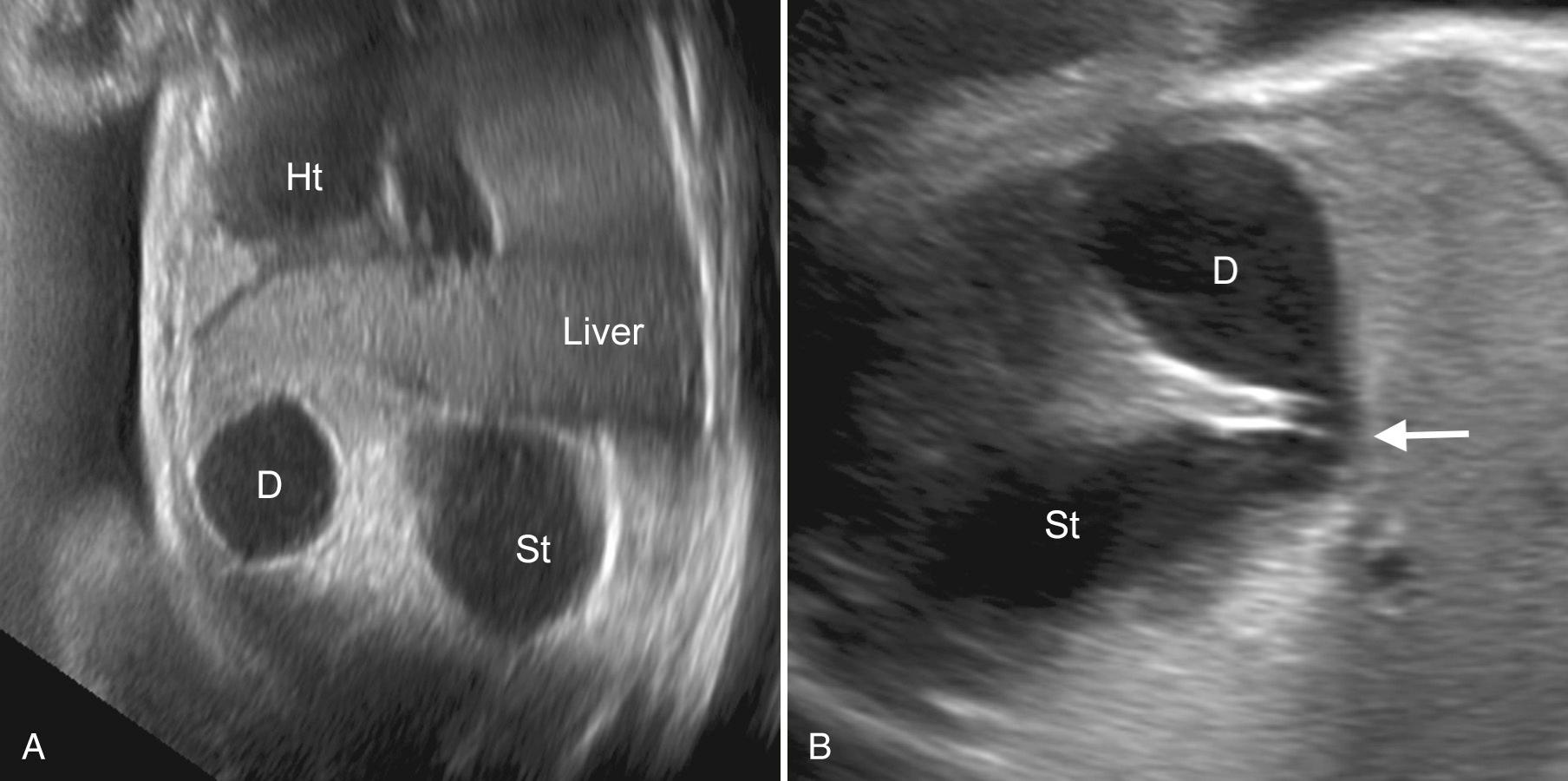
A prominent incisura angularis of the stomach may be mistaken for a “double bubble” if these are in different planes, but a careful real-time longitudinal examination of the stomach can eliminate this possibility. Other, less common reasons for an apparent double-bubble sign include choledochal cyst and duodenal duplication cyst. In addition, several cases of transient double-bubble sign during the second trimester have been reported, with normal outcomes.
As in all cases of proximal bowel obstruction, polyhydramnios is frequently present by the late second trimester but is often absent in the early second trimester at the time of routine fetal survey. This is in part related to the relative difference in the amount of amniotic fluid swallowed per day at different times of gestation. The fetus swallows a relatively small amount of amniotic fluid (2-7 mL of fluid per day) during early second trimester, compared to 450 mL at term. In a European study of 138 cases of postnatally confirmed duodenal atresia, polyhydramnios was present in only 33% of cases. For these reasons, duodenal atresia is commonly diagnosed during the third trimester, whereas in the early second trimester both false-negative and false-positive diagnoses have been reported. Thus the proportion of cases diagnosed prenatally ranges widely between 34% and 87%.
It has been suggested that prenatal diagnosis of duodenal atresia has the potential to decrease neonatal morbidity. Finding the double-bubble sign should trigger detailed anatomic survey, fetal echocardiography, as well as genetic counseling and consideration of amniocentesis given the high association with trisomy 21.
The prevalence of jejunoileal atresia ranges from 0.5 to 1.1 cases per 10,000 live births. Jejunal atresias are slightly more common (51%) than ileal. The most common hypothesis with respect to the etiology for jejunoileal atresia is early vascular compromise of the developing midgut. In animals, induced vascular compromise leads to isolated bowel atresias. This hypothesis is also supported by the association of intestinal atresia with placental complications and other abnormalities of vascular origin such as gastroschisis. “Apple peel” jejunal atresia is a subtype that involves agenesis of the mesentery, is more often familial, and is likely of a different etiology. Cystic fibrosis is a common underlying cause of ileal obstruction; the thick meconium associated with cystic fibrosis can lead to ileal obstruction (meconium ileus) with or without echogenic bowel.
Although jejunal and ileal atresia are often discussed as a single entity, there are major differences between these two conditions. Jejunal atresia is more likely to involve multiple sites and is less often associated with in utero perforation than is ileal atresia, likely because of the lower compliance of the ileum. In addition, the risk of associated anomalies depends on the site of obstruction. Whereas jejunal atresias have been associated with extra-GI anomalies and chromosomal disorders in up to 42% of cases, the rate of associated anomalies in cases of ileal atresia is only about 2%. Both conditions are associated with other GI abnormalities, including malrotation, meconium peritonitis, and duplication cysts.
The prenatal diagnosis of jejunoileal obstruction is based on dilated loops of bowel ( Fig. 38.9 , Video 38.5 ), most frequently without a dilated stomach and sometimes with hyperperistalsis. If peristalsis is not observed, dilated small bowel can be difficult to distinguish from dilated colon. The cutoff used to define dilated small bowel is greater than 7 mm for loop diameter or greater than 13 mm for loop length. The diagnosis of jejunoileal atresia is typically not made until late in the second trimester, as dilatation of the bowel is often not seen before that stage. The rate of polyhydramnios decreases as the site of bowel obstruction becomes more distal. Thus polyhydramnios in cases of jejunoileal atresia is less common than in cases of duodenal or esophageal atresia; it has been reported in about one-third of cases of jejunal atresia and is even less common in cases of ileal atresia. It is often not possible to confidently differentiate between jejunal and ileal atresia in utero; the more dilated loops visible, the more likely it is to be a distal or ileal obstruction. Another sonographic sign associated with jejunoileal obstruction is echogenic bowel, reflecting thickened meconium due to the intestinal stasis. Ascites and abdominal calcifications can be seen in cases of obstruction complicated by perforation, a complication seen more commonly in cases of ileal obstruction. In a recent systematic review on the accuracy of sonographic diagnosis of small bowel obstruction, a large variation in the detection rate of small bowel obstruction was noted (10%-100%), with the detection rate being considerably higher for jejunal atresia (66%) than for ileal atresia (26%).
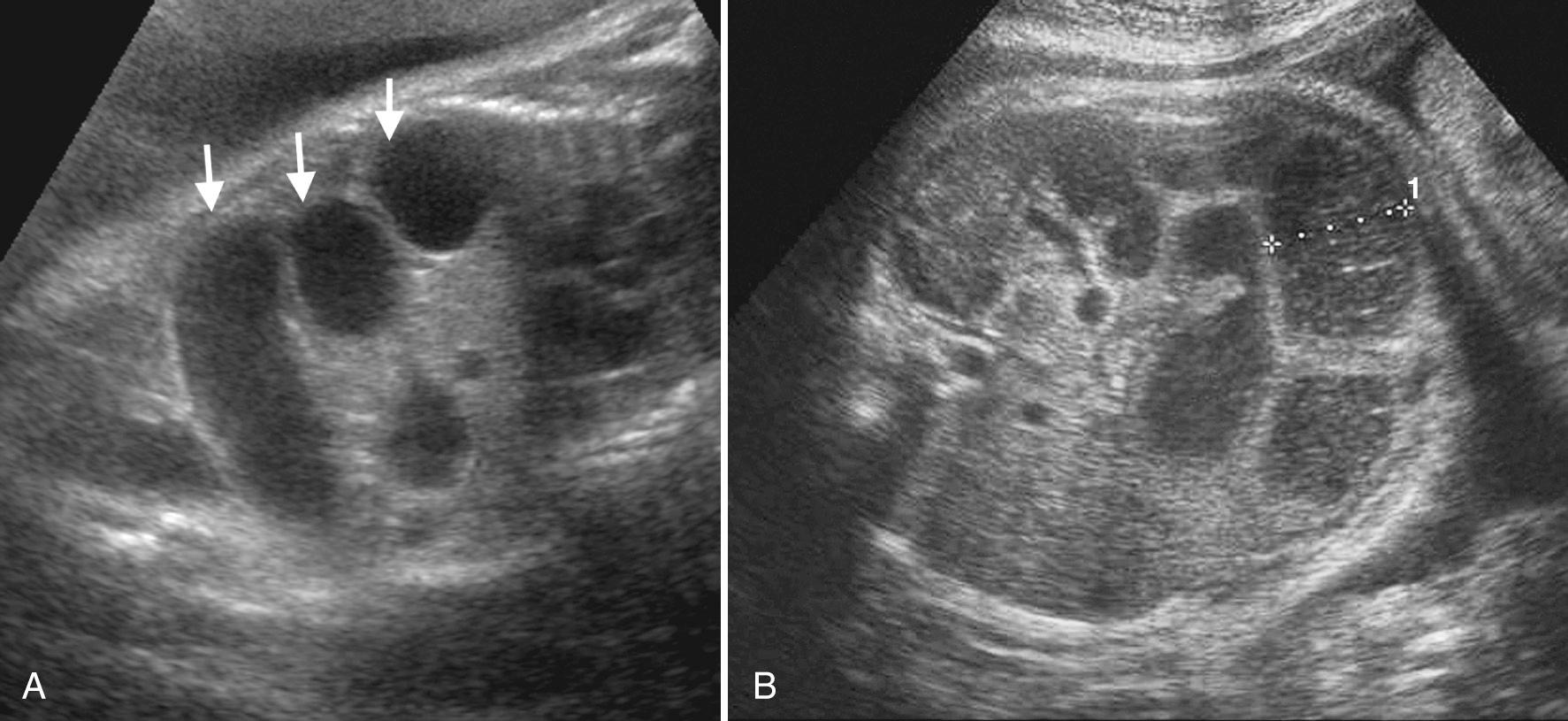
Meconium ileus relates to obstruction of the ileum by thickened meconium. Some cases are associated with cystic fibrosis, but only a minority (up to 20%) of cases of cystic fibrosis will present with meconium ileus during pregnancy. The presence of echogenic bowel in addition to the general sonographic signs of bowel obstruction increases the likelihood of meconium ileus. The differential diagnosis and diagnostic approach in cases of echogenic bowel and meconium peritonitis are discussed later in this chapter.
The incidence of anorectal malformation is in the range of 0.8 to 4 per 10,000 live births. The spectrum of anorectal malformations ranges from isolated imperforate anus to more complex cloacal malformations. They are classified as low, intermediate, and high based on whether the bowel ends below, at the same level, or above the level of the levator ani muscle, respectively. The majority of cases (>90%) are low malformations. High malformations are less common and are often associated with vesicocolic fistulas.
Anorectal malformations are frequently associated with chromosomal and structural anomalies, in 48% to 98% of cases. Anal atresia is also part of the VACTERL sequence and is associated with a large number of genetic syndromes. Given the high rate of associated abnormalities, a detailed fetal survey, fetal echocardiogram, genetic counseling, and discussion of aneuploidy risk should be included in the management of cases with suspected anorectal malformations.
The prenatal detection rate of anorectal malformations is lower than that of more proximal types of bowel obstruction and ranges from 7% to 24%. The main sonographic sign is dilated loops of small or large bowel, although this should be distinguished from normal prominent colon loops during the third trimester ( Fig. 38.10A ). Polyhydramnios is absent in the majority of cases. Sonographic assessment would commonly reveal signs of associated anomalies such as in the case of VACTERL association and associated chromosomal abnormalities. In cases complicated by vesicocolic fistula, intraluminal calcifications may be seen and have been attributed to mixing of meconium with urine. More recently, inability to visualize the anal mucosa on transverse transperineal view (known as the anal dimple, which is the result of the echogenic mucosa surrounded by the hypoechoic muscle of the anal sphincter) has been suggested as an important sonographic marker in cases of imperforated anus ( Fig. 38.10B ).
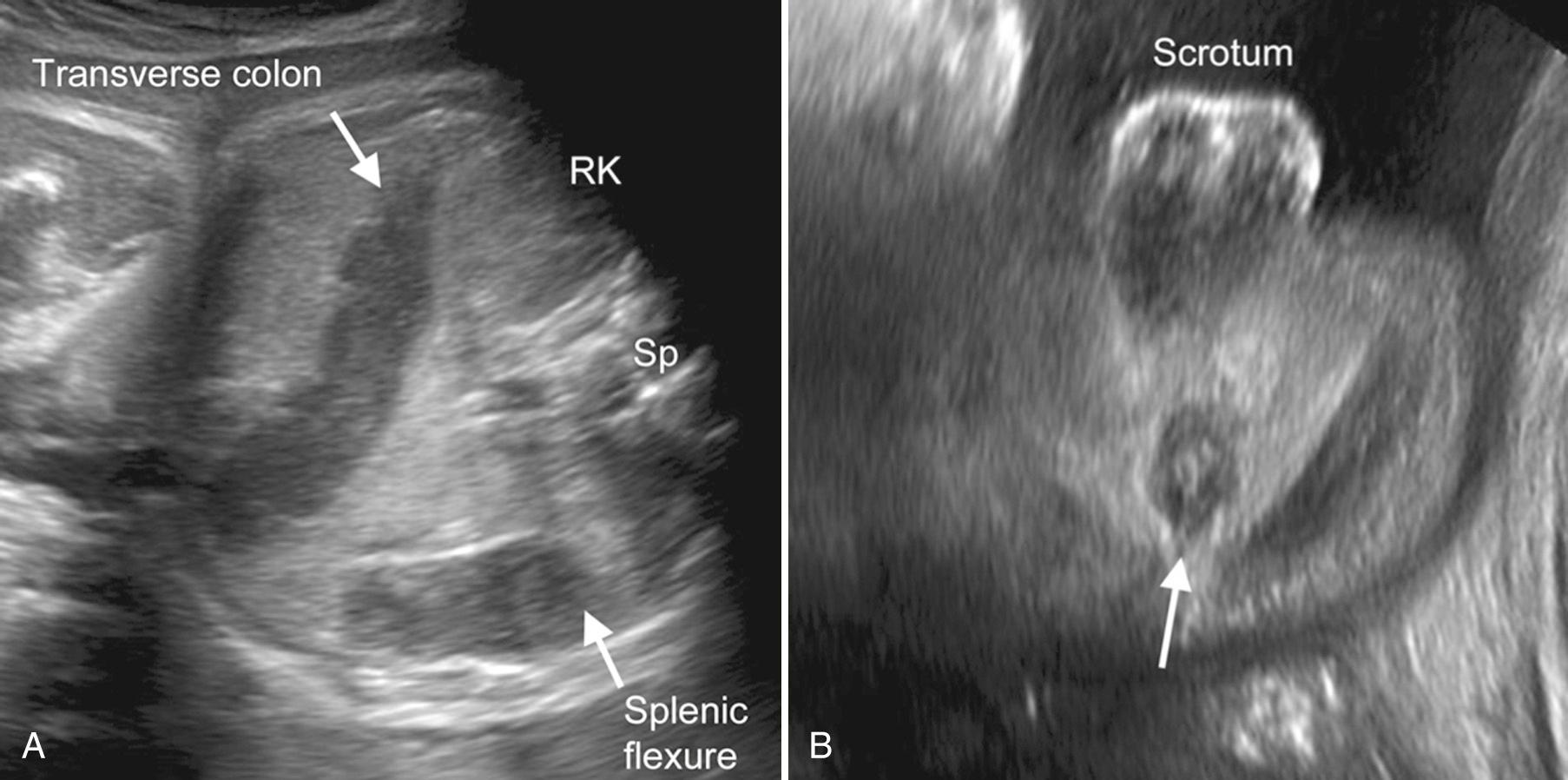
Hirschsprung disease is a congenital disorder of the colon caused by absence of ganglia in the distal colon, thereby leading to functional colonic obstruction. It affects about 1 of 5000 live births. The diseased segment usually involves the most distal part of the colon, including the internal anal sphincter, and extends proximally to involve variable portions of the colon, with the most severe forms involving the whole colon. Hirschsprung disease is associated with chromosomal and structural abnormalities in about 10% to 20% of cases, and up to 10% of cases are associated with trisomy 21.
Prenatal diagnosis of Hirschsprung disease is uncommon and is usually made in severe forms involving the entire length of colon. The sonographic signs in these cases are nonspecific and include bowel dilatation, polyhydramnios, and echogenic bowel ( Fig. 38.11 ). Thus the majority of cases are diagnosed within the early neonatal period, with the most common sign being failure to pass meconium.
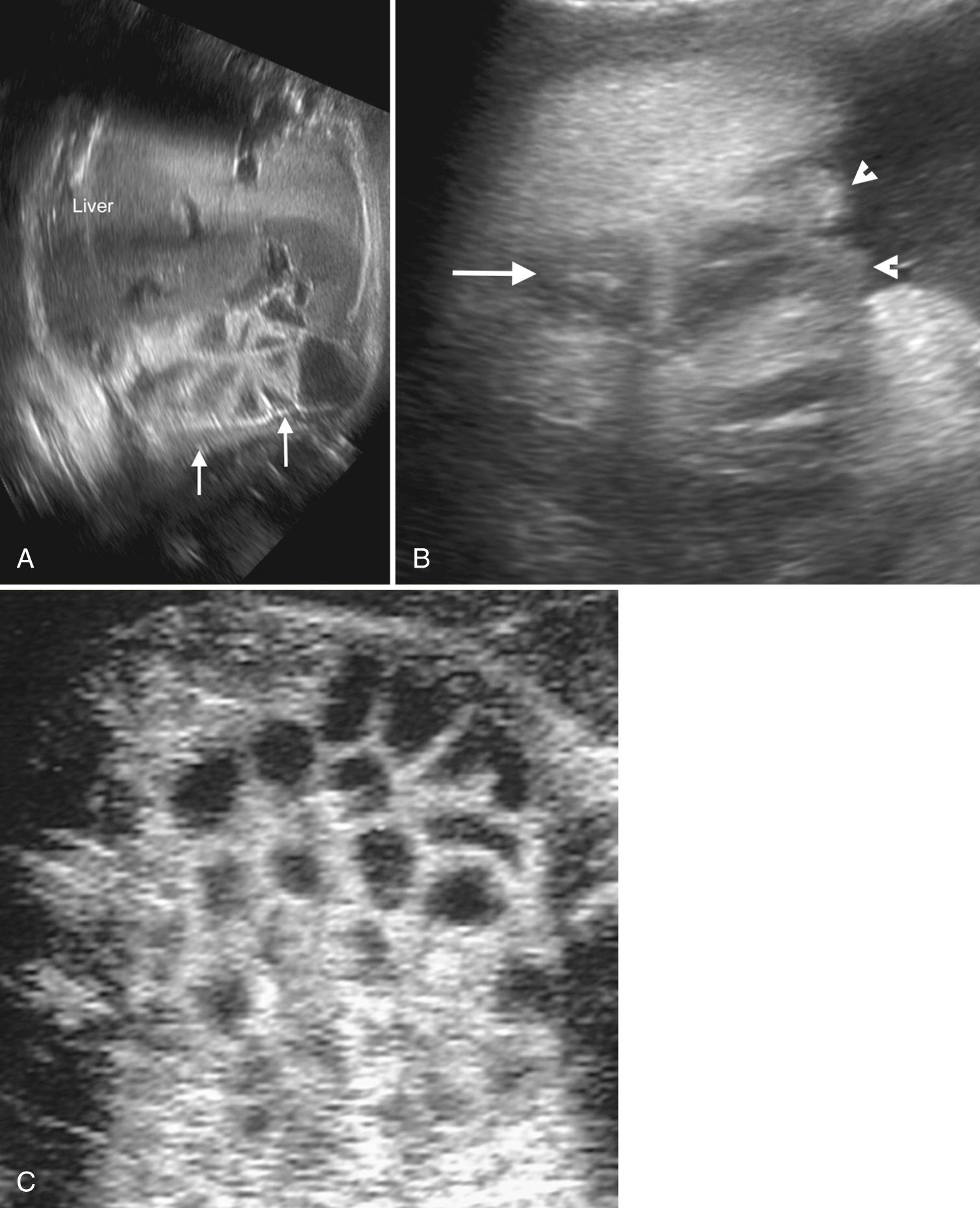
Enteric duplication cysts are classified by the anatomic region involved rather than by the histology of the mucosal lining. The incidence is estimated at 1 per 10,000 infants. They result from abnormal recanalization of the GI tract and may or may not communicate with the lumen of the GI tract. Enteric duplication cysts can be associated with any area of the GI tract, but they are most common in the terminal ileum. They may present in utero or postnatally either as an incidental finding or in association with bowel obstruction. Associated anomalies occur in up to 30% of cases, most often of the GI tract.
Enteric duplication cysts present at ultrasound as cystic or echogenic tubular structures with well-defined borders. They are classically anechoic and cystic but at times are filled with echogenic material. The borders typically have a double layer (“gut signature”), although this may be hard to demonstrate and may require high-resolution linear transducers ( Fig. 38.12 , Video 38.6 ). Depending on the site of presentation, the differential diagnosis includes hepatic cysts, choledochal cysts, bowel atresias, and ovarian cysts. Peristalsis of the cysts can help differentiate these masses from those of non-GI origin. Postnatally, the standard treatment is surgical because of the associated risk of bowel obstruction.
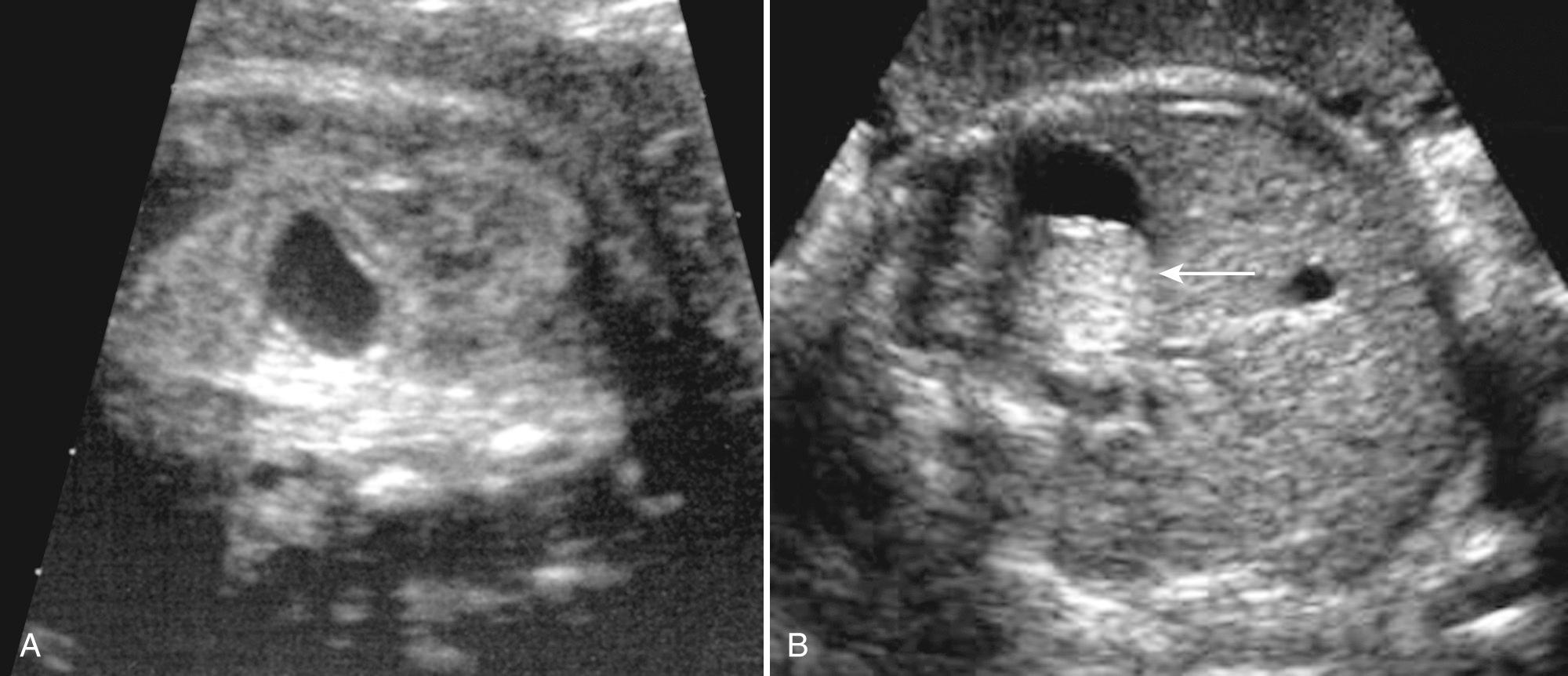
Become a Clinical Tree membership for Full access and enjoy Unlimited articles
If you are a member. Log in here